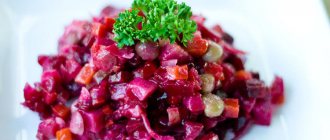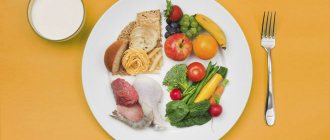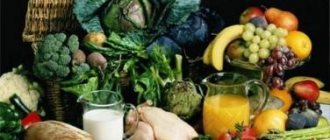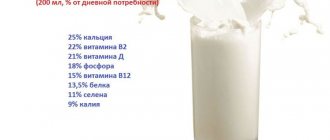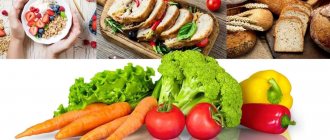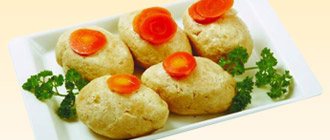For stomach diseases, the presence of first courses as part of the diet is simply necessary. They are allowed even during exacerbation of the disease. However, there are certain nuances here too. It is important to take into account what kind of broth the first dish is prepared in, what is put in it, how the vegetables are processed before cooking, etc. The stage of development of the disease and the acidity of the stomach are also of great importance. When the acidity of the stomach is high, some foods are contraindicated; when the acidity is low, others are contraindicated.
The well-known borscht is the number one dish in every Slavic family. It is nutritious, contains a complex of vitamins and minerals necessary for the normal functioning of the human body, especially during illness. But this delicious dish also contains foods that can cause irritation to the mucous membranes and lead to a deterioration in well-being. So, is it possible to treat borscht for gastritis, how is it beneficial, and how is it harmful for the stomach and the body as a whole?
Cooking methods
- Article on the topic Dietary table No. 2. How to eat with gastritis, colitis and after infections? cooking in water and steaming
- baking
- frying without breading and without crust
Can:
- Butter (including ghee), refined vegetable oils.
- Berry, fruit, vegetable juices diluted with water.
- Milk, cooked cottage cheese, yogurt, kefir, fermented baked milk. No more than a dessert spoon of sour cream per dish. Cheese.
- Steam omelet, unfried scrambled eggs, soft-boiled eggs.
- Yesterday's bread, dry biscuit.
- Porridge mashed in water (can be done with milk), small pasta (chopped or vermicelli).
- Soups on a weak, low-fat broth with pureed cereals and vegetables.
- Vegetables: cauliflower, carrots, beets, zucchini, pumpkin, potatoes. Possible tomatoes, white cabbage, green peas.
- Coffee, cocoa, tea with the addition of cream, milk or lemon if desired.
- Candies, jam, honey, sugar, marshmallows, marshmallows.
It is forbidden:
- Flour products from puff pastry and butter dough, fresh bread.
- Bean, pea, milk soup, okroshka, millet soup.
- Fatty meat, poultry, smoked meats, goose, duck. Limit lamb and pork.
- Snack food canned fish, smoked and salted fish.
- Hard-boiled eggs.
- Limit barley, pearl barley, and corn grits.
- Excessively fatty and spicy snacks, canned food, smoked foods.
- Spicy and fatty sauces, horseradish, pepper, mustard.
- Kvass, grape juice.
- Pork lard, lamb, beef and cooking fats.
Is borscht allowed for gastritis?
Borscht is one of the most delicious and common dishes of Slavic cuisine; moreover, it contains a lot of vitamins and minerals, which are important for the human body. However, when using it, it is worth considering some factors:
- stage of disease development;
- acidity of gastric juice;
- what products the dish consists of and what recipe it was prepared according to.
Regarding the consumption of traditional borscht by patients with gastritis, experts have conflicting opinions. The above factors are of great importance. Borscht also contains white cabbage, which is used as the main vegetable of the dish. It negatively affects the functioning of the inflamed organ: it causes flatulence and disruption of the gastrointestinal tract. Therefore, it must be replaced with a more gentle option, for example, Chinese cabbage. Same with broth. Traditional borscht is cooked in fatty meat broth, which is extremely undesirable for gastritis. It is preferable to use low-fat and non-concentrated broths: vegetable, fish, chicken or veal. Hot spices (red and black pepper, suneli hops) also need to be replaced with dill or parsley. It is worth giving up garlic, bell pepper and vinegar, which are also used in borscht.
Consequently, borscht is not a dietary dish, however, there is no clear prohibition on its consumption.
In the classic version, for gastritis with high acidity, borscht is not acceptable.
However, if this dish is prepared according to a special recipe (follow all the doctors’ recommendations), then it will bring maximum benefits to the stomach, normalize its functioning, and help restore inflamed walls.
Omelette with cauliflower
Omelette with cauliflower Photo: Million menu
3 protein
100 g cauliflower
1 tbsp. sour cream
4-5 tbsp. milk
1 tsp ghee
Salt
Step 1. Boil the cauliflower and place in a greased form.
Step 2. Beat the egg whites with milk and pour the mixture over the cabbage. Bake in the oven for 7 minutes.
Step 3. Serve with sour cream and melted butter.
Useful properties of borscht
Borscht is a balanced dish.
It contains proteins, fats, carbohydrates, vitamins, minerals and enzymes in an optimal ratio. Vegetables and seasonings (in particular, herbs: dill, parsley) are rich in vitamins B, C, K, organic acids, folic and pantothenic acids, amino acids, carotenoids and mineral salts. The broth in which the delicious dish is prepared has a beneficial effect on the gastrointestinal tract and controls blood viscosity, thins it, which is very important for the cardiovascular system.
Borscht contains a lot of healthy proteins.
It activates and normalizes metabolic processes in the body. The vegetables that make up the dish are rich in fiber, which acts as an excellent sorbent. It gently removes harmful substances from the body: toxins, radionuclides, nitrates, while retaining beneficial substances in the body.
Types of disease
Gastritis can be of high or low acidity. Beverages are a fundamental product. Low acidity? Drink carbonated table water before meals, trying to activate the digestive glands. Symptoms of gastritis:
- heaviness;
- heartburn;
- hiccups;
- nausea;
- vomit;
- loose stools;
- constipation;
- stomach ache.
Borscht recipes
Light version.
For those who find it difficult to give up their favorite dish, you can make a light version that will be very healthy and tasty:
- Add chopped potatoes to boiling weak meat broth and cook for 5 minutes. Then finely chop the Chinese cabbage and put it in a saucepan. Bring to a boil, cover with a lid, reduce heat and let the borscht simmer.
- At this time, the frying is being prepared. But the vegetables are not fried, but stewed. Grate the carrots, put them in a frying pan, add liquid, maybe some broth, and simmer until soft. Then add boiled beets, cut into strips, add a small tomato (cut into slices).
- Simmer the vegetables for five minutes and add them to the pan. Let the borscht simmer for a few minutes and then turn it off. Serve this borscht with sour cream or cream. Bon appetit!
Vegetarian borscht.
You can also make vegetarian borscht. It differs from the previous one in the complete absence of meat broth:
- Chop the Chinese cabbage and potatoes and cook, add a little salt.
- While the vegetables are cooking, during this time sauté the beets, carrots, parsley roots and flour in a small amount of broth and add to the vegetables in the pan. Cook for 15 minutes over low heat.
- Season the finished and cooled borscht with olive oil, add a little salt, sugar, and herbs.
Properly prepared borscht is allowed for inflammation of the gastric mucosa. However, before using it, you should consult your doctor. Since at a certain acidity of the stomach a number of foods are prohibited.
Nuances of preparation
There are many different recipes for borscht, cabbage soup and soups for people suffering from various diseases of the gastrointestinal tract. However, they all have something in common. First of all, this concerns the broth. It must be prepared in two waters. That is, first the meat must be cooked for a certain time in one liquid, and then in another. In this way, you can reduce the amount of unhealthy fat that enters the body of a sick person.
The rest of the principle of preparing borscht remains unchanged - you need to add vegetables to the second broth as it cooks. After this, you need to reduce the heat and bring the first dish until cooked.
Also, some people need to pay attention to the frying for borscht, since many people prepare it with certain errors that are unacceptable if a person is sick. Vegetables should never be fried - they must be stewed. That is why you need to make sure that there is a small amount of liquid in the pan, into which you first need to add the carrots, then the rest of the ingredients. It is best to cut vegetables into strips - this way they will cook faster, which is why the chance of overcooking them is significantly reduced.
How to use?
In addition to lean borscht, there are many other types of first courses that gastroenterologists allow patients to eat. These are vegetable and vegetarian borscht, cabbage soup, with nettle and sorrel. But not everyone can eat these borschts; here one should take into account the acidity of the stomach, at what stage the disease is progressing or is in a period of chronicity with weakening symptoms (remission). In any case, you should consult your doctor before consuming this dish. Based on the patient’s health and tests, he will recommend a specific option, which will exclude those components that can harm the diseased organ.
Let us highlight the main points that should be taken into account when preparing borscht for a patient suffering from gastritis:
- borscht should not be eaten too hot or cold;
- do not put acidic foods in it that stimulate excessive production of gastric juice;
- the dish should not contain tomato paste;
- borscht should be lean;
- Do not fry, vegetables can only be lightly stewed.
What is included in borscht?
In its classic form, this dish consists of the following components:
- beet;
- beans;
- carrot;
- potato;
- cabbage;
- onion;
- tomato;
- fat: vegetable oil or piece of meat.
Separately, subject to proper preparation, all these products can be eaten by patients with gastritis. But in borscht the ingredients begin to interact with each other. Vegetables give up the extractive (secretion-stimulating) substances they contain to boiling water, resulting in a broth. If the dish is not vegetarian, then the meat provides additional fat. At the end, each housewife adds spices at her own discretion, and the food acquires new taste qualities and increases its extractive abilities.
Diet for acute gastritis
23.04.2021
The doctor diagnoses gastritis and prescribes a strict diet ? Therefore, it is important to know how to eat and choose foods correctly. In this article you can find everything you need to keep your stomach in optimal condition.
Basic rules for eating
- Divide your daily food intake into 6 meals.
- Avoid hunger.
- Grind your food.
- Cool food before eating.
- Eat without haste.
- Avoid spices.
- It is necessary to avoid salty, fried, canned, smoked and spicy foods.
- Completely eliminate the use of alcohol and cigarettes.
Prohibited foods for acute gastritis
- Sparkling water and kvass
- Salted and pickled foods
- Fried food
- Duck, goose, pork and fatty fish;
- Products prepared by smoking
- Various canned foods
- Ice cream and chocolate
- Rye bread
- All citrus fruits, spinach, sorrel, cabbage
- Fruits and vegetables without heat treatment
- Mushrooms
- All types of sauces
- Garlic, onion, radish, radish
Allowed foods for acute gastritis
- Hard cheeses, low-fat sausages
- Turkey, chicken, lean fish, beef, veal, rabbit. Products should be boiled in broth or steamed.
- Cream soup
- Oat flakes on water. A small amount of milk can be added
- Boiled vegetables
- Fruits in compote or jelly. The fruit should not be sour
- Low fat dairy products
- Bakery products must be dried
- Soft-boiled eggs, omelet. You are allowed to eat a maximum of a couple of eggs per day.
- Weak tea, cocoa, freshly squeezed non-acidic juices diluted with water
- For those with a sweet tooth, you can eat marshmallows, marshmallows or jelly. The diet does not prohibit sugar intake
Sample menu for the week
A nutritionist compiles it based on the rules and list of acceptable foods.
Monday
- 1st meal - buckwheat porridge, tea, milk soufflé.
- 2nd reception - oatmeal broth with sugar.
- 3rd meal - soup (slimy) made from rice, beef with spaghetti, peas and boiled carrots, cocoa.
- 4th method – cottage cheese with a low fat content.
- 5th method - steam cutlets, casserole of vegetables and rabbit meat and a decoction of herbs with honey.
- 6th dose – 250 ml of milk.
Tuesday
- 1st meal - dry bread, oatmeal, boiled egg, rosehip and apple decoction.
- 2nd reception - dry biscuit, 250 ml of compote.
- 3rd meal - vegetable soup, steamed poultry, grated pumpkin, milk tea (you can add sugar).
- 4th meal - dried toast, 250 ml of milk (or any low-fat fermented milk drink).
- 5th meal - steamed beef cutlets with noodles, vegetable salad with sour cream, cocoa.
- 6th dose - 250 ml of fermented baked milk.
Wednesday
- 1st meal - boiled fish, oatmeal, milk.
- 2nd method - milk jelly.
- 3rd meal - soup with chicken and vegetables, grated potatoes and carrots, steam cutlet, cocoa.
- 4th method - low-fat cottage cheese.
- 5th meal - boiled peas with stewed meatballs, dried toast, compote.
- 6th reception - milk or kefir.
Thursday
- 1st meal - toast, low-fat cottage cheese with honey, compote.
- 2nd dose – 250 ml of milk or kefir.
- 3rd meal - pureed potato soup, vegetable casserole with rabbit meat, compote.
- 4th reception - milk mousse with baked fruits.
- 5th meal - boiled rabbit meat in broth, boiled carrots and peas, tea with milk.
- 6th reception - cocoa with milk.
Friday
- 1st meal - oatmeal, toast, boiled egg, cocoa with milk.
- 2nd dose - 250 ml of sweet oat broth.
- 3rd meal - pea puree, fried pumpkin, steamed fish.
- 4th method - milk jam.
- 5th meal – steamed fish, vegetable casserole, rosehip decoction.
- 6th reception - kefir.
Saturday
- 1st meal - buckwheat with milk, airy soufflé, weak tea.
- 2nd dose - 250 ml of milk, baked fruit.
- 3rd meal - zrazy with steamed rice, cauliflower soup, cocoa.
- 4th meal - weak tea and oatmeal cookies.
- 5th meal - peas with carrots and steamed fish, vegetables with sour cream, rose hip decoction.
- 6th meal - 1 glass of low-fat fermented baked milk.
Sunday
- 1st meal – baked apples with cottage cheese and raisins, toast and freshly squeezed juice diluted with water.
- 2nd dose – milk or kefir.
- 3rd meal – vegetable soup with chicken, mashed potatoes and carrots, steam cutlet, cocoa with added milk.
- 4th method – low fat cottage cheese with honey.
- 5th meal – boiled chicken with vermicelli, baked pumpkin, cocoa with milk.
- 6th method – fruit jelly.
If you follow all the rules of this diet , gastritis will quickly go into remission.
Published in Gastroentorology Premium Clinic
Characteristics of borscht
The main difference between borscht and cabbage soup is its brighter and richer color, smell and taste. Because of this, this first dish is deservedly popular among many people. In general, if we greatly simplify the cooking process, we can conclude that borscht is essentially cabbage soup with the addition of garlic, beets and tomatoes.
The combination of sour cream, pepper and garlic makes Ukrainian borscht especially attractive. These ingredients can significantly change the entire flavor palette of a dish. People without problems with the gastrointestinal tract tolerate such products well, but for those with gastritis, such combinations can be very unfavorable.
At the moment, there are many modifications of traditional borscht, one of which is the most acceptable for patients with gastroenterological diseases - lean borscht. This type of first course was invented in Moscow at the Metropol restaurant. It is based on traditional borscht recipes, but slightly modified to suit the requirements of nutritionists.
The main components of lean borscht include:
- grated carrots;
- shredded cabbage;
- sauteed onion;
- diced potatoes;
- sunflower oil;
- salt;
- grated tomatoes;
- dill;
- water.
In general, lean borscht is almost identical to cabbage soup. But there are certain differences between these dishes. The Lenten dish uses either vegetable broth or chicken broth. In addition, no spices, seasonings, garlic or hot peppers are added to it. As a result, the taste of lean borscht is slightly sweet. It is best eaten without sour cream and bread. There are no contraindications for its use by people with gastritis.
Use for high acidity
The goal of dietary recommendations for these patients is to reduce stimulation of the gastric glands. Excess digestive juice injures the mucous membrane, this causes pain and deterioration of the person’s condition. Therefore, it is so important not to provoke hypersecretion with food.
If you replace the usual stages of preparing borscht, it can be consumed with increased secretory capacity of the stomach, without fear of heartburn.
| Habitual action | Alternative | Result |
| Cook meat broth based on fatty pork | Use lean beef or chicken, drain the water in which the meat is boiling several times. It’s better to switch to a vegetarian option with vegetable oil | The fat level in the finished dish will be reduced. Requires less digestive juices to process it |
| Preparing the dressing: frying onions, carrots, peppers, tomatoes in oil | Simmer vegetables in a small amount of water, over low heat, covered | With this processing method, the extractive properties of products are less pronounced. |
| Adding fresh or sauerkraut | Use only pre-prepared vegetables, not the white variety. | The overall acidity of the finished dish will decrease, provocation of the mucous membrane will be less |
| Spices: bay leaf, brine, | Replace with salt, dill and parsley | The ability of borscht to cause secretion of gastric glands will be significantly reduced. |
So, with this type of gastritis, eating borscht is allowed provided that all cooking rules are followed. They will not spoil the taste of the finished dish, although it will be different. This option will be useful not only for a person with gastritis, but also for all members of his family.



